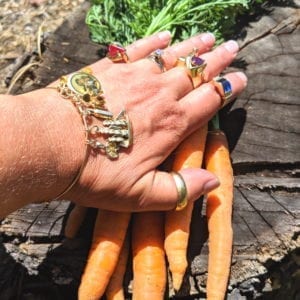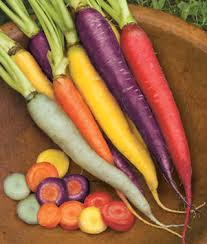Hiya!
Today we are going to talk about carrots, carats, karats, and the differences between the three! They are all pronounced the same but yet have very distinct differences.



I am going to “assume” that we all know what a carrot is. I’m talking about the “What’s Up Doc?” kind. The kind that Bugs Bunny liked to munch on! A carrot, daucus carota is a root vegetable plant of the parsley family. They are edible. They can be eaten raw or cooked and are quite nutritious! Carrots are usually orange in color but can also be yellow, purple or a hot pink, reddish color. Like carats they can be quite colorful! But this is where the similarities stop.

A carat is a weight of measurement equal to 200mg. Most often people associate carats with diamonds. However, gemstones in general, both precious and semi-precious stones can and many times are weighed in carats. Many people commonly mistake “carats” to refer the size of a diamond or other precious gemstone. Someone might say “OMG can you believe the size of that diamond? It must be at least 3 carats!” A one carat (ct. abbreviation for carat) diamond or ruby for that matter weighs 1 ct. A 1.5 ct. sapphire weighs 1.5 carats, a 2.1 ct. diamond weights 2.1 cts. You get the picture!
Granted a 3 ct. diamond will most likely be bigger than a 1 ct. diamond. On the other hand a .8 ct. diamond might actually be larger than a 1.2 ct. diamond depending on how it is cut. It’s all about the weight, not the size!

Diamonds weighing less than 1ct are often divided into “points.” One hundred “points” equals one carat. Therefore, a 1/4ct diamond (.25ct) would equal 25pts. A .10ct diamond would equal 10pts.
The terms carat and karat are often confused and sometimes even thought to mean the same thing. The simplest explanation is that one is a unit of measurement, carat. While the other, karat is a unit of pureness or fineness.
Karat is a measure of gold in fine jewelry and has absolutely nothing to do with weight. Decades ago, for whatever reason, it was decided that 24 karats would represent 100% gold. Why? It has been said this was from the Greeks who had a seed called keration, which was used in ancient times to weigh pearls. In Byzantium from 312 AD to 1453 AD, there was a gold coin called solidus. The solidus weighed 24 kerations. Since that was the measure of the day it carried forward through time. Even though karatage is about purity and not weight, the concept that pure gold is 24 parts has remained the measure of pure gold.

In the US 14Kt. gold is sort of the “gold standard” no pun intended! In Europe and other parts of the world 18Kt. gold is most common. 14Kt. gold contains 14 parts gold or 58% gold. Both white and yellow gold contain 58% gold. 18Kt. gold is much more “yellow” and brilliant in color than 14Kt gold.
Why only 14 parts gold, and what then is the rest? First off gold is a soft metal. To give gold strength and make it suitable for jewelry rarely will pure gold be used. Depending on what metal and or metals that make up the other 42%, will make the difference in the color and the price! Some common alloys that are often added are palladium, platinum and silver. Nickel, copper and zinc are also used and much cheaper than gold!
For example, 18Kt. yellow gold may include 75% gold, and a mixture of 20% silver and 5% copper. 18Kt. white gold may have a mixture of 75% gold and 25% palladium or platinum. This explains the price difference between white and yellow gold with white gold being a bit more expensive all other factors remaining equal. 18Kt. rose gold may have a mix of 75% gold, 20% copper and 5% silver. This not only gives rose gold its pinkish color, but explains why of the three colors, yellow, white and rose why rose gold is the least expensive of the three. All manufactures will use a different mix and both the price and color will reflect the mix of metals!
As Bugs (and then Porky Pig) used to say “That’s All Folks.” 
ENJOY!!
cheryl
